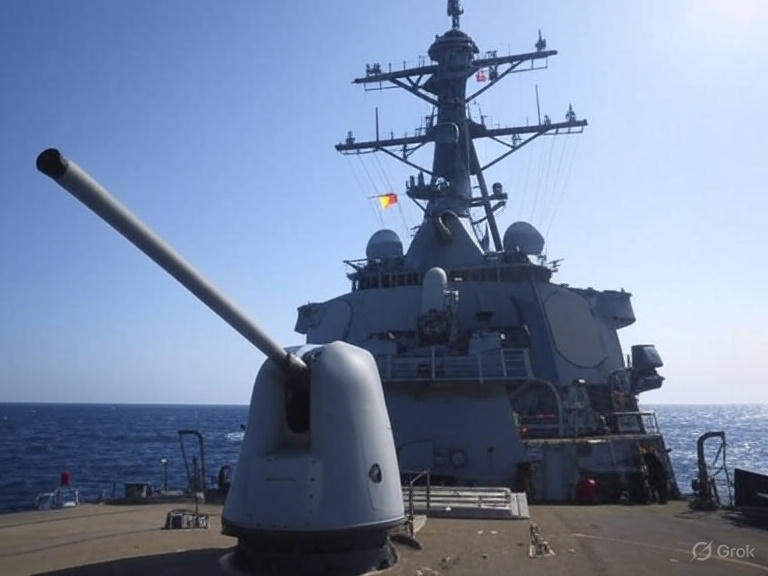In a stunning display of military innovation, the French Army has successfully tested a revolutionary drone swarm launched from an engineer craft navigating a river. This cutting-edge development, conducted in 2025, marks a significant milestone in modern warfare, blending advanced technology with tactical ingenuity. The trial showcases the French military’s commitment to staying at the forefront of defense technology, leveraging unmanned aerial systems (UAS) to enhance operational capabilities in dynamic and challenging environments.
The Test: A Leap into the Future
The French Army’s recent test involved deploying a swarm of drones from an engineer craft, specifically designed to operate on riverine environments. This trial, conducted under the supervision of the French Directorate General of Armaments (DGA), demonstrated the seamless integration of small, agile drones with waterborne platforms. The engineer craft, typically used for tasks like bridge-building and river crossings, was repurposed as a mobile launch platform, showcasing its versatility in modern combat scenarios.
The drones, compact and highly maneuverable, were launched in a coordinated swarm, demonstrating their ability to operate autonomously or under remote control. These unmanned systems are designed to perform a variety of tasks, including reconnaissance, surveillance, target acquisition, and potentially even offensive operations. The river-based launch adds a new dimension to their deployment, allowing the French Army to project power from unconventional platforms in diverse terrains.
The test was conducted in a controlled environment, with the engineer craft navigating a river while launching the drone swarm. The drones communicated with each other and the control unit on the craft, executing pre-programmed maneuvers with precision. This capability highlights the potential for drone swarms to operate in complex environments where traditional air or land-based deployments may be limited.
Why River-Launched Drone Swarms Matter
The development of river-launched drone swarms represents a paradigm shift in military tactics. Rivers, often strategic assets in warfare, provide natural corridors for movement and concealment. By equipping engineer crafts with drone-launching capabilities, the French Army can exploit these waterways to deploy unmanned systems rapidly and discreetly. This approach offers several tactical advantages:
- Stealth and Mobility: Launching drones from a moving river craft makes it harder for adversaries to detect and counter the operation. The mobility of the craft allows for rapid repositioning, enabling dynamic responses to battlefield conditions.
- Versatility in Terrain: Rivers often traverse difficult terrains, such as dense forests or urban areas, where traditional airfields or launch sites may not be feasible. River-launched drones can access these areas, providing critical intelligence and support.
- Force Multiplication: A swarm of drones can cover a wide area, performing multiple roles simultaneously. This capability enhances situational awareness and allows commanders to make informed decisions in real-time.
- Cost-Effectiveness: Engineer crafts are already part of the French Army’s inventory, and retrofitting them for drone operations is a cost-effective way to enhance their utility without requiring entirely new platforms.
Technological Innovations Behind the Swarm
The success of the river-launched drone swarm test is underpinned by several technological advancements. The drones themselves are equipped with cutting-edge features, including:
- Autonomous Navigation: Advanced algorithms enable the drones to operate independently, avoiding obstacles and coordinating with other drones in the swarm.
- Swarm Intelligence: The drones communicate with each other in real-time, sharing data and adapting to changing conditions. This collective intelligence ensures robust performance even if individual drones are lost.
- Compact Design: The drones are lightweight and portable, allowing them to be stored and launched from the confined space of an engineer craft.
- Multi-Mission Capabilities: Equipped with sensors, cameras, and potentially small payloads, the drones can perform a range of tasks, from intelligence gathering to precision strikes.
The engineer craft, meanwhile, has been modified to serve as a stable launch platform. This includes reinforced deck areas, communication systems to interface with the drones, and possibly automated launch mechanisms to streamline deployment. The integration of these technologies demonstrates the French Army’s ability to adapt existing assets for futuristic applications.
Strategic Implications for Modern Warfare
The successful test of river-launched drone swarms has far-reaching implications for military strategy. As global conflicts increasingly involve hybrid warfare—combining conventional, unconventional, and technological elements—the ability to deploy drones from non-traditional platforms offers a significant advantage. The French Army’s innovation could inspire other militaries to explore similar concepts, potentially reshaping how forces are deployed in riverine and coastal environments.
Moreover, the use of drone swarms aligns with broader trends in military modernization. Nations worldwide are investing heavily in unmanned systems, recognizing their potential to reduce risks to human personnel while enhancing operational effectiveness. The French Army’s approach, however, stands out for its creative use of existing infrastructure, demonstrating that innovation does not always require entirely new systems.
Challenges and Future Prospects
While the test marks a significant achievement, several challenges remain. Coordinating a drone swarm in a riverine environment requires robust communication systems to overcome potential interference from water, terrain, or enemy countermeasures. Additionally, ensuring the drones’ autonomy and resilience in contested environments will be critical for operational success.
Looking ahead, the French Army plans to refine this technology, potentially integrating it into larger exercises and real-world operations. Future developments could include:
- Enhanced Payloads: Equipping drones with advanced sensors or non-lethal payloads for crowd control or electronic warfare.
- Interoperability: Integrating the drone swarm with other French military assets, such as ground vehicles, aircraft, or naval vessels.
- Scalability: Expanding the size of the swarm or adapting the technology for larger watercraft, such as patrol boats or amphibious vessels.
Global Context: A Race for Drone Dominance
The French Army’s test comes at a time when global powers are racing to develop and deploy advanced drone technologies. Countries like the United States, China, and Israel have made significant strides in unmanned systems, with applications ranging from surveillance to autonomous combat. The French innovation adds a unique dimension to this race, emphasizing the importance of adaptability and unconventional deployment methods.
As militaries worldwide observe the French Army’s progress, the river-launched drone swarm could become a model for future developments. It also underscores the importance of investing in research and development to maintain a technological edge in an increasingly competitive global landscape.
Conclusion
The French Army’s successful test of a river-launched drone swarm represents a bold step forward in military technology. By combining the mobility of engineer crafts with the versatility of drone swarms, France is pioneering a new approach to warfare that could redefine tactical operations. As the technology matures, it has the potential to enhance the French Army’s capabilities in reconnaissance, rapid response, and force projection, all while leveraging existing assets in innovative ways.
This breakthrough serves as a reminder of the transformative power of technology in modern warfare. As the French Army continues to refine and expand this capability, the world will be watching closely, eager to see how this innovation shapes the future of military strategy.




